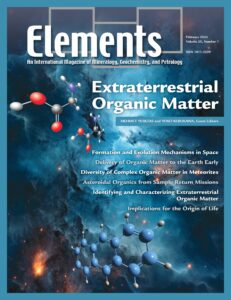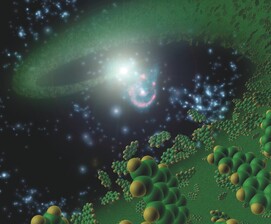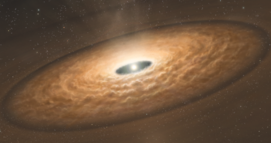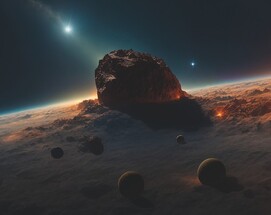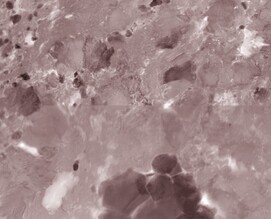Extraterrestrial Organic Matter
Mehmet Yesiltas and Yoko Kebukawa – Guest Editors
Table of Contents
Extraterrestrial organic matter is found in various extraterrestrial environments and in various forms. It forms in a variety of locations through different mechanisms in space. As such, its nature, distribution, formation mechanisms and locations are of particular interest. Some organic molecules are even considered as key players for the emergence of life on Earth and possibly beyond. Therefore, their detection and characterization can contribute to the understanding of the early solar system evolution as well as the origin of life. Despite decades of work and research, there are still many questions and unknowns on this topic. The aim of this issue of Elements is to offer an overview of the concept of extraterrestrial organic matter as well as the latest scientific findings.
- Extraterrestrial Organic Matter: An Introduction
- Formation and Evolution Mechanisms of Organic Matter in Space
- Delivery of Organic Matter to Early Earth
- Diversity of Complex Organic Matter in Carbonaceous Chondrites, IDPs, and UCAMMs
- Asteroidal Organics from the Sample Return Mission Hayabusa2 and their Implication for Understanding our Origins
- Analytical Techniques for Identification and Characterization of Extraterrestrial Organic Matter
PAIRED METAMORPHIC BELTS OF SW JAPAN: METAMORPHIC RECORDS OF A SUBDUCTION SYSTEM
Guest Editors: S. R. Wallis (University of Tokyo, Japan), K. Miyazaki (Geological Survey of Japan, AIST, Japan), and U. Knittel (RWTH Aachen University, Germany)
Subduction, where one plate dives beneath another, controls longterm wholeEarth cycling of rocks, fluids and energy. Plates subduct faster than they heat up, making them the coldest parts of the Earth’s interior. Fluids released from these cold plates rise into hotter overlying rocks forming magma that feeds surface volcanism. Cold deep conditions associated with subduction complemented by hot shallow conditions under volcanic arcs are reflected in the presence of pairs of metamorphic belts representing sites of ancient subduction—the Cretaceous SanbagawaRyoke metamorphic pair of Japan is a premier example. Estimates of pressure, temperature, the age and duration of metamorphism, and the tectonic framework in which metamorphism took place help us develop quantitative models both for the evolution of SW Japan and subduction systems in general.
- Paired Metamorphism in SW Japan S. R. Wallis (University of Tokyo, Japan), K. Miyazaki (Geological Survey of Japan, AIST, Japan), and T. Okudaira (Osaka Metropolitan University, Japan)
- Sanbagawa Subduction: What Went In, How Deep, and How Hot Did It Get S. Endo (Shimane University, Japan), Y. Kouketsu (Nagoya University, Japan), and M. Aoya (Tokushima University, Japan)
- Mantle Wedge of the Sanbagawa Subduction Zone A. Okamoto (Tohoku University, Japan), T. Nagaya (University of Tokyo, Japan), S. Endo (Shimane University, Japan), and T. Mizukami (Kanazawa University)
- Geochronology of the Sanbagawa Belt: Younger and Faster Than Ever Before U. Knittel (RWTH Aachen University, Germany), T. Tokiwa (Shinshu University, Japan), Y. Tsutsumi (National Museum of Nature and Science, Japan), S. Endo (Shimane University, Japan), and S. R. Wallis (University of Tokyo, Japan)
- Metamorphism Beneath the Ryoke Volcanic Arc: Timing and P–T conditions T. Okudaira (Osaka Metropolitan University, Japan), T. Kawakami (Kyoto University, Japan), T. Ikeda (University of Kyushu, Japan), and E. Skrzypek (University of Graz, Austria)
- Cretaceous Plate Movements in the Eastern Pacific Domain and the Geology of Japan J. Wu (University of Houston, USA), S.-J. Wu (University of Houston, USA), and K. Yamaoka (Geological Survey of Japan, AIST, Japan)
- Thermal Models of the Ryoke and Sanbagawa Metamorphic Domains K. Miyazaki (Geological Survey of Japan, AIST, Japan), K. Ishii (Osaka Metropolitan University, Japan), S. R. Wallis (University of Tokyo, Japan), and C. Annen (Institute of Geophysics Czech Academy of Science, Czech Republic)
- Extraterrestrial Organic Matter (February 2024)
- Paired Metamorphic Belts of SW Japan: Metamorphic Records of a Subduction System (April 2024)
- Cratons Receive the Highest Grades (June 2024)
- The Invisible Ocean: Hydrogen in the Deep Earth (August 2024)
- Behind and Beyond Luminescence Imaging (October 2024)



